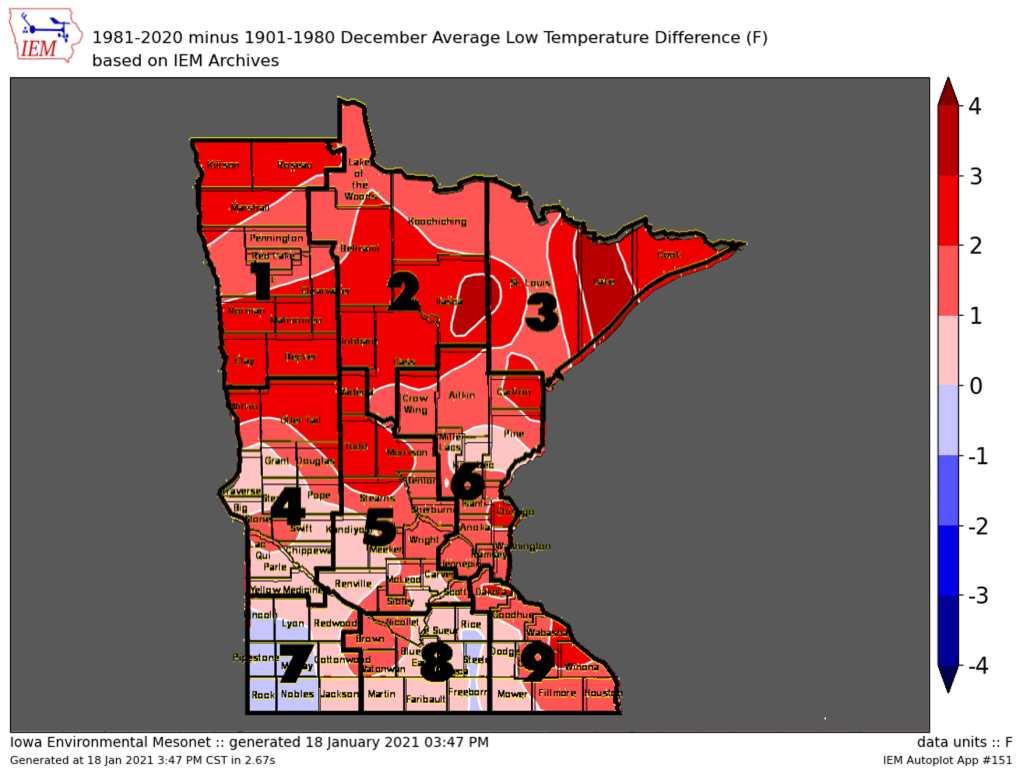Minnesota’s winters have been warming significantly faster than summers over the last several decades. In fact, the state’s winters are among the fastest warming in the U.S. This warming trend is likely increasing the time in which winter temperatures are near freezing, which could increase the number of freeze-thaw events. An increase in freeze-thaw events could have detrimental effects on Minnesota’s pavement systems.
MnDOT recently completed a comprehensive assessment of climate data in Minnesota with correlations to freeze-thaw cycles in pavement to understand how warming winters are impacting the sustainability of pavement.
“Although researchers found that precipitation is increasing and this trend can potentially lead to more pavement deterioration, the good news is that warmer winters have actually decreased the number of freeze-thaw cycles, which means less pavement deterioration from that process,” said Raul Velasquez, geomechanics research engineer, MnDOT Office of Materials and Road Research.
Fluctuating temperatures cause water that seeps into pavement and subsurface soil to repeatedly freeze and thaw. When the water freezes, it expands and causes frost heave—areas of pavement are pushed up and could potentially crack. Thawing ice contracts in volume, weakening the pavement and reducing load-bearing capacity, potentially causing cracking, potholes and other damage. The severity of the pavement damage during and after a winter season is dependent on the number of freeze-thaw cycles.
MnDOT wanted to know if the warming climate is increasing freeze-thaw events that result in pavement damage. Understanding the effects of changes in environmental conditions on pavement life can help engineers design more sustainable pavement.
What Was Our Goal?
In the first phase of this research, the goal was to understand the changes in Minnesota’s climate and whether the number of freeze-thaw events that impact pavement quality are increasing.
What Did We Do?
A multidisciplinary research team representing pavement systems, climate and data science, and geotechnical engineering performed a comprehensive assessment of climate data in Minnesota to understand the implications for pavement management.
First, they analyzed climate trends through several historical data sources, including data from temperature and moisture sensors in the pavement and subsurface at the MnROAD testing facility and data from MnDOT’s seasonal load limits program, which identifies spatial and temporal distribution of subsurface temperature, moisture and freeze-thaw depths. Other data sources included:
- Temperature data from the Federal Highway Administration’s Long-Term Pavement Performance program sites.
- The Road Weather Information System’s atmospheric, pavement and subsurface temperatures, and precipitation.
- Daily air and soil temperatures, precipitation and frost depth data from the National Oceanic and Atmospheric Administration.
- Data to simulate past atmospheric, surface and subsurface environmental conditions from the National Aeronautics and Space Administration.
- Iowa Environmental Mesonet, a compilation of environmental data sets from Iowa State University.
Next, researchers defined the freeze-thaw cycle relevant to pavement damage. The research team studied the frost-susceptibility and freezing points of soils and pavements, moisture levels and which temperatures—air, surface, pavement layers or subsurface—are relevant in determining whether freezing and thawing will damage pavement. Here, researchers quantified freeze-thaw events based on temperatures in the air and at different pavement depths for two duration sets within a 24-hour period. Soil moisture levels and different freezing temperatures for different materials were also considered.

To quantify freeze-thaw events at different pavement layers, cells at MnROAD were chosen based on whether they contained the appropriate sensors, the completeness of the data record and moisture levels. Then, through detailed statistical analyses, the research team developed correlations between air, pavement and subsurface temperatures during the freeze-thaw events.
What Did We Learn?
Through comprehensive data mining and computational analyses, researchers determined pavement freeze-thaw cycles in multiple contexts. In the past 40 years statewide, they found days are one to two degrees Fahrenheit warmer and nights are two to five degrees Fahrenheit warmer, and the number of below-freezing days has decreased.
“We are finding that the changes in climate—mainly increasing temperatures and precipitation—have more impact on the long-term performance of pavement infrastructures than do traffic loadings,” said Halil Ceylan, director, Iowa State University Program for Sustainable Pavement Engineering and Research.
Researchers did not find an overall, clear increase in the number of freeze-thaw cycles as they and MnDOT might have expected. Rather, cycle quantity decreased at shallower pavement depths in early and late winter, and no trend (random) was observed for the rest of the winter and in deeper pavement and subgrade levels. These results are applicable to the MnROAD location and may not be representative of the rest of the state. Freeze-thaw cycles using air temperatures were random throughout the decades analyzed, with most events occurring in early and late winter.
Of significant interest due to the implications for pavement damage, researchers found an increase in precipitation of 0.5 to 1 inch both before and at the end of the cold season. More moisture can exacerbate heaving in the pavement and subgrade.
What’s Next?
MnDOT remains interested in managing pavement operations in the context of the changing climate. While this research provided important groundwork on climate data sources and indications of pavement freeze-thaw cycle trends at MnROAD, Phase II of this project promises to result in more comprehensive knowledge and practical tools.
The research team will analyze the implications of increased precipitation and expand the exploration of climate impacts on pavement across the state, producing a moisture-induced vulnerability map for the pavement foundation of the entire road network.


Good day!
The 30-year standard reference periods under World Meteorological Organization recommendation absent compared in analysis climatical changing.
Fairly thick pavement less susceptible to freeze-thaw cycles. Very good bases improve the stability. What to do the present road – open question.
This work as a whole is well done.